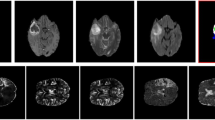Abstract
Deep learning has achieved state-of-the-art performance in automated brain tumor segmentation from magnetic resonance imaging (MRI) scans. However, the unexpected occurrence of poor-quality outliers, especially in out-of-distribution samples, hinders their translation into patient-centered clinical practice. Therefore, it is important to develop automated tools for large-scale segmentation quality control (QC). However, most existing QC methods targeted cardiac MRI segmentation which involves a single modality and a single tissue type. Importantly, these methods only provide a subject-level segmentation-quality prediction, which cannot inform clinicians where the segmentation needs to be refined. To address this gap, we proposed a novel network architecture called QCResUNet that simultaneously produces segmentation-quality measures as well as voxel-level segmentation error maps for brain tumor segmentation QC. To train the proposed model, we created a wide variety of segmentation-quality results by using i) models that have been trained for a varying number of epochs with different modalities; and ii) a newly devised segmentation-generation method called SegGen. The proposed method was validated on a large public brain tumor dataset with segmentations generated by different methods, achieving high performance on the prediction of segmentation-quality metric as well as voxel-wise localization of segmentation errors. The implementation will be publicly available at https://github.com/peijie-chiu/QC-ResUNet.
Access this chapter
Tax calculation will be finalised at checkout
Purchases are for personal use only
Similar content being viewed by others
References
Baid, U., et al.: The RSNA-ASNR-MICCAI BraTS 2021 benchmark on brain tumor segmentation and radiogenomic classification. arXiv preprint arXiv:2107.02314 (2021)
Bergstra, J., Bengio, Y.: Random search for hyper-parameter optimization. J. Mach. Learn. Res. 13(2) (2012)
Drozdzal, M., Vorontsov, E., Chartrand, G., Kadoury, S., Pal, C.: The importance of skip connections in biomedical image segmentation. In: Carneiro, G., et al. (eds.) LABELS/DLMIA -2016. LNCS, vol. 10008, pp. 179–187. Springer, Cham (2016). https://doi.org/10.1007/978-3-319-46976-8_19
He, K., Zhang, X., Ren, S., Sun, J.: Deep residual learning for image recognition. In: Proceedings of the IEEE Conference on Computer Vision and Pattern Recognition, pp. 770–778 (2016)
Ioffe, S., Szegedy, C.: Batch normalization: accelerating deep network training by reducing internal covariate shift. In: International Conference on Machine Learning, pp. 448–456 (2015)
Isensee, F., Jaeger, P.F., Kohl, S.A., Petersen, J., Maier-Hein, K.H.: nnU-Net: a self-configuring method for deep learning-based biomedical image segmentation. Nat. Methods 18(2), 203–211 (2021)
Isensee, F., Kickingereder, P., Wick, W., Bendszus, M., Maier-Hein, K.H.: Brain tumor segmentation and radiomics survival prediction: contribution to the BRATS 2017 challenge. In: Crimi, A., Bakas, S., Kuijf, H., Menze, B., Reyes, M. (eds.) BrainLes 2017. LNCS, vol. 10670, pp. 287–297. Springer, Cham (2018). https://doi.org/10.1007/978-3-319-75238-9_25
Kamnitsas, K., et al.: Efficient multi-scale 3D CNN with fully connected CRF for accurate brain lesion segmentation. Med. Image Anal. 36, 61–78 (2017)
Kofler, F., et al.: Deep quality estimation: creating surrogate models for human quality ratings. arXiv preprint arXiv:2205.10355 (2022)
Kohlberger, T., Singh, V., Alvino, C., Bahlmann, C., Grady, L.: Evaluating segmentation error without ground truth. In: Ayache, N., Delingette, H., Golland, P., Mori, K. (eds.) MICCAI 2012. LNCS, vol. 7510, pp. 528–536. Springer, Heidelberg (2012). https://doi.org/10.1007/978-3-642-33415-3_65
Maas, A.L., Hannun, A.Y., Ng, A.Y., et al.: Rectifier nonlinearities improve neural network acoustic models. In: Proceedings of the ICML, Atlanta, Georgia, USA, vol. 30, p. 3 (2013)
Robinson, R., et al.: Real-time prediction of segmentation quality. In: Frangi, A.F., Schnabel, J.A., Davatzikos, C., Alberola-López, C., Fichtinger, G. (eds.) MICCAI 2018. LNCS, vol. 11073, pp. 578–585. Springer, Cham (2018). https://doi.org/10.1007/978-3-030-00937-3_66
Robinson, R., et al.: Automated quality control in image segmentation: application to the UK Biobank cardiovascular magnetic resonance imaging study. J. Cardiovasc. Magn. Reson. 21(1), 1–14 (2019)
Ronneberger, O., Fischer, P., Brox, T.: U-Net: convolutional networks for biomedical image segmentation. In: Navab, N., Hornegger, J., Wells, W.M., Frangi, A.F. (eds.) MICCAI 2015. LNCS, vol. 9351, pp. 234–241. Springer, Cham (2015). https://doi.org/10.1007/978-3-319-24574-4_28
Tompson, J., Goroshin, R., Jain, A., LeCun, Y., Bregler, C.: Efficient object localization using convolutional networks. In: Proceedings of the IEEE Conference on Computer Vision and Pattern Recognition, pp. 648–656 (2015)
Ulyanov, D., Vedaldi, A., Lempitsky, V.: Instance normalization: the missing ingredient for fast stylization. arXiv preprint arXiv:1607.08022 (2016)
Valindria, V.V., et al.: Reverse classification accuracy: predicting segmentation performance in the absence of ground truth. IEEE Trans. Med. Imaging 36(8), 1597–1606 (2017)
Wang, S., et al.: Deep generative model-based quality control for cardiac MRI segmentation. In: Martel, A.L., et al. (eds.) MICCAI 2020. LNCS, vol. 12264, pp. 88–97. Springer, Cham (2020). https://doi.org/10.1007/978-3-030-59719-1_9
Zhuge, Y., et al.: Brain tumor segmentation using holistically nested neural networks in MRI images. Med. Phys. 44(10), 5234–5243 (2017)
Acknowledgements
All computations were supported by the Washington University Center for High Performance Computing, which was partially funded by NIH grants S10OD025200, 1S10RR022984-01A1, and 1S10OD018091-01.
Author information
Authors and Affiliations
Corresponding author
Editor information
Editors and Affiliations
Rights and permissions
Copyright information
© 2023 The Author(s), under exclusive license to Springer Nature Switzerland AG
About this paper
Cite this paper
Qiu, P., Chakrabarty, S., Nguyen, P., Ghosh, S.S., Sotiras, A. (2023). QCResUNet: Joint Subject-Level and Voxel-Level Prediction of Segmentation Quality. In: Greenspan, H., et al. Medical Image Computing and Computer Assisted Intervention – MICCAI 2023. MICCAI 2023. Lecture Notes in Computer Science, vol 14223. Springer, Cham. https://doi.org/10.1007/978-3-031-43901-8_17
Download citation
DOI: https://doi.org/10.1007/978-3-031-43901-8_17
Published:
Publisher Name: Springer, Cham
Print ISBN: 978-3-031-43900-1
Online ISBN: 978-3-031-43901-8
eBook Packages: Computer ScienceComputer Science (R0)





